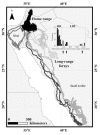Using tri-axial acceleration data to identify behavioral modes of free-ranging animals: general concepts and tools illustrated for griffon vultures
- PMID: 22357592
- PMCID: PMC3284320
- DOI: 10.1242/jeb.058602
Using tri-axial acceleration data to identify behavioral modes of free-ranging animals: general concepts and tools illustrated for griffon vultures
Abstract
Integrating biomechanics, behavior and ecology requires a mechanistic understanding of the processes producing the movement of animals. This calls for contemporaneous biomechanical, behavioral and environmental data along movement pathways. A recently formulated unifying movement ecology paradigm facilitates the integration of existing biomechanics, optimality, cognitive and random paradigms for studying movement. We focus on the use of tri-axial acceleration (ACC) data to identify behavioral modes of GPS-tracked free-ranging wild animals and demonstrate its application to study the movements of griffon vultures (Gyps fulvus, Hablizl 1783). In particular, we explore a selection of nonlinear and decision tree methods that include support vector machines, classification and regression trees, random forest methods and artificial neural networks and compare them with linear discriminant analysis (LDA) as a baseline for classifying behavioral modes. Using a dataset of 1035 ground-truthed ACC segments, we found that all methods can accurately classify behavior (80-90%) and, as expected, all nonlinear methods outperformed LDA. We also illustrate how ACC-identified behavioral modes provide the means to examine how vulture flight is affected by environmental factors, hence facilitating the integration of behavioral, biomechanical and ecological data. Our analysis of just over three-quarters of a million GPS and ACC measurements obtained from 43 free-ranging vultures across 9783 vulture-days suggests that their annual breeding schedule might be selected primarily in response to seasonal conditions favoring rising-air columns (thermals) and that rare long-range forays of up to 1750 km from the home range are performed despite potentially heavy energetic costs and a low rate of food intake, presumably to explore new breeding, social and long-term resource location opportunities.
Figures






Similar articles
-
Decision-making by a soaring bird: time, energy and risk considerations at different spatio-temporal scales.Philos Trans R Soc Lond B Biol Sci. 2016 Sep 26;371(1704):20150397. doi: 10.1098/rstb.2015.0397. Philos Trans R Soc Lond B Biol Sci. 2016. PMID: 27528787 Free PMC article.
-
Mixed strategies of griffon vultures' (Gyps fulvus) response to food deprivation lead to a hump-shaped movement pattern.Mov Ecol. 2013 Jul 5;1(1):5. doi: 10.1186/2051-3933-1-5. eCollection 2013. Mov Ecol. 2013. PMID: 25709819 Free PMC article.
-
AcceleRater: a web application for supervised learning of behavioral modes from acceleration measurements.Mov Ecol. 2014 Dec 25;2(1):27. doi: 10.1186/s40462-014-0027-0. eCollection 2014. Mov Ecol. 2014. PMID: 25709835 Free PMC article.
-
The veterinary use of diclofenac and vulture conservation in Spain: Updated evidence and socio-ecological implications.Sci Total Environ. 2021 Nov 20;796:148851. doi: 10.1016/j.scitotenv.2021.148851. Epub 2021 Jul 3. Sci Total Environ. 2021. PMID: 34271379 Review.
-
Dropping dead: causes and consequences of vulture population declines worldwide.Ann N Y Acad Sci. 2012 Feb;1249:57-71. doi: 10.1111/j.1749-6632.2011.06293.x. Epub 2011 Dec 16. Ann N Y Acad Sci. 2012. PMID: 22175274 Review.
Cited by
-
The environmental-data automated track annotation (Env-DATA) system: linking animal tracks with environmental data.Mov Ecol. 2013 Jul 3;1(1):3. doi: 10.1186/2051-3933-1-3. eCollection 2013. Mov Ecol. 2013. PMID: 25709817 Free PMC article.
-
Accelerometers identify new behaviors and show little difference in the activity budgets of lactating northern fur seals (Callorhinus ursinus) between breeding islands and foraging habitats in the eastern Bering Sea.PLoS One. 2015 Mar 25;10(3):e0118761. doi: 10.1371/journal.pone.0118761. eCollection 2015. PLoS One. 2015. PMID: 25807552 Free PMC article.
-
Do power lines and protected areas present a catch-22 situation for Cape vultures (Gyps coprotheres)?PLoS One. 2013 Oct 9;8(10):e76794. doi: 10.1371/journal.pone.0076794. eCollection 2013. PLoS One. 2013. PMID: 24137496 Free PMC article.
-
Prying into the intimate secrets of animal lives; software beyond hardware for comprehensive annotation in 'Daily Diary' tags.Mov Ecol. 2015 Sep 21;3(1):29. doi: 10.1186/s40462-015-0056-3. eCollection 2015. Mov Ecol. 2015. PMID: 26392863 Free PMC article.
-
Individual Monitoring of Activity and Lameness in Conventional and Slower-Growing Breeds of Broiler Chickens Using Accelerometers.Animals (Basel). 2023 Apr 22;13(9):1432. doi: 10.3390/ani13091432. Animals (Basel). 2023. PMID: 37174469 Free PMC article.
References
-
- Altun K., Barshan B., Tuncel O. (2010). Comparative study on classifying human activities with miniature inertial and magnetic sensors. Pattern Recognit. 43, 3605–3620
-
- Boettiger A., Wittemyer G., Starfield R., Volrath F., Douglas-Hamilton I., Getz W. M. (2011). Inferring ecological and behavioral drivers of elephant movement using a linear filtering approach. Ecology 92, 1648–1657 - PubMed
-
- Bouten C. V., Westerterp K. R., Verduin M., Janssen J. D. (1994). Assessment of energy expenditure for physical activity using a triaxial accelerometer. Med. Sci. Sports Exerc. 26, 1516–1523 - PubMed
-
- Breiman L. (2001). Random forests. Mach. Learn. 45, 5–32
-
- Byrnes G., Libby T., Lim N. T. L., Spence A. J. (2011). Gliding saves time but not energy in Malayan colugos. J. Exp. Biol. 214, 2690–2696 - PubMed
Publication types
MeSH terms
Grants and funding
LinkOut - more resources
Full Text Sources
Molecular Biology Databases

